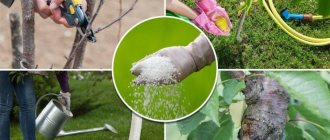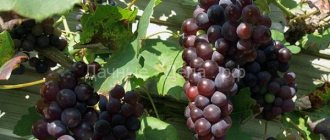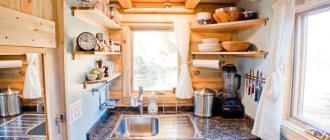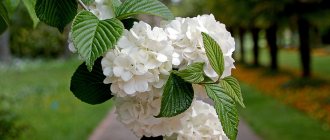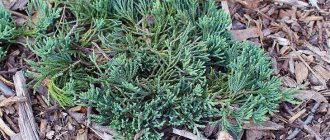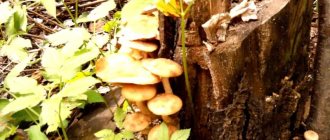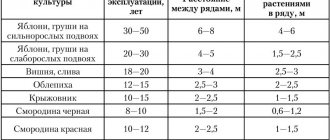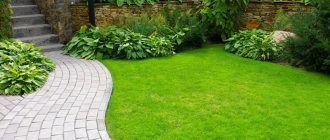Don’t know how to buy quality thuja seedlings? This article will help you not only purchase good planting material, but also grow an attractive tree.
Thuja seedlings should be purchased with a closed root system. This can be an earthen ball wrapped in burlap, but it is better if the plants “live” in small containers (pots). Such thujas can be planted in open ground at any time from spring to mid-autumn, until cold weather sets in. It is recommended to plant plants with a ball of earth from late April to mid-May: at this time the roots take root better.
How to choose thuja seedlings?
If the roots of the plant stick out from the drainage holes in the pot or are located on the surface of the ground, it means that the thuja has been in this container for a very long time. This kind of material is not worth taking.
Carefully inspect the seedling: there should be no signs of diseases, damaged shoots, or peeled bark.
Mature and large plants are sold with a ball of earth wrapped in burlap and metal mesh, or in large containers. Such thujas should have a well-developed root system and a fairly lush crown. At the same time, 3-4 months before planting on the site, the roots of such a plant need to be slightly trimmed in order to stimulate the formation of young suction roots.
Emerald
An evergreen tree with bright green needles looks great in yards, parks and squares. Many country property owners are interested in how to plant thuja Smaragd. This procedure does not require much effort; you just need to purchase a healthy seedling. You also need to choose a suitable location for the plant.
Designers often give the crown fancy shapes. The frost-resistant variety is ideal for the city; the plant purifies the air from harmful substances. It is used for single plantings and used to form hedges.

Planting thuja seedlings
When planting a seedling of any age, it is very important to preserve the root ball.
Container thujas must be watered well before planting.
The size of the planting hole depends on the size of the ball; usually its depth and width range from 0.6 to 1 m. Remember: the diameter and depth of the hole should be 2 times the diameter of the root ball.
Remove the seedling from the container very carefully so that the root ball does not fall apart
If you plan to place the thuja on clay or wet soil, be sure to pour a 20-30 cm layer of drainage made of crushed stone, expanded clay, sand or broken brick at the bottom of the hole. Then fill the hole with fertile soil. It is best to use one of these soil mixtures :
- turf or leaf soil, peat and sand in a ratio of 2:1:1;
- leaf soil, sand, peat, humus – 2:2:1:3;
- turf soil, humus and sand – 3:2:1.
In addition, it is advisable to add mineral fertilizers to the soil mixture. Ideally, 50-100 g of nitroammophoska.
Thuja needs to be planted in prepared soil so that its root collar is at ground level.
Immediately after planting, the plant must be watered, even if it is raining at that moment. This is done so that the soil is compacted and there are no voids left in it.
To make the thuja take root faster, you can add any growth stimulant (for example, Epin, Zircon, Kornevin) to the water for irrigation.
After which it is recommended to mulch the tree trunk circle with peat, compost, chopped bark or wood chips. The thickness of the mulch layer should be 5-7 cm.
Thanks to mulching, seedlings take root faster, their roots are reliably protected from overheating and drying out in the summer and freezing in the winter.
Sunkist
A low tree with needles of a rich golden color has a pyramid-shaped crown. The photo of planting thujas of this variety shows that the plants can decorate any area. The tree usually grows up to 2 meters in height. It exudes an amazing aroma. The shade of the needles depends on the time of year.

The golden tree looks beautiful against the backdrop of green plants and flower beds. The Sunkist variety is used to decorate garden paths and as a hedge around the perimeter of a personal plot.

Primary care of thuja seedlings
For a month after planting, thuja must be watered at least once a week. The soil should not be allowed to dry out. If there is a lack of moisture, the crown of the plant will thin out. Plus, the soil in the tree trunk circle should be loosened to a depth of 5-7 cm.
When initially caring for thuja, the main thing is to follow the watering regime.
In the future, the frequency of watering is adjusted depending on the weather and soil type. In this case, it is advisable to spray the crown at least once a week with water, the temperature of which is equal to the air temperature in the area. This is best done early in the morning and in the evening after sunset.
As you can see, planting thuja is not at all difficult. This attractive coniferous plant will decorate your site all year round and will not require careful care.
The most interesting types and varieties of thuja for the middle zone
The evergreen thuja, an unpretentious, fast-growing coniferous plant, cannot be found under natural conditions in our country. The thing is that the homeland of these conifers from the cypress family is North America, and in our country various nurseries of ornamental and coniferous plants are engaged in breeding and zoning.
It is no coincidence that thuja is popularly called the “royal tree” - this stately beauty used to decorate only the alleys of royal palaces. Today, thuja is quite accessible to every amateur gardener, and many species and varieties of this plant are successfully used in the design of gardens, parks and local areas. Many, but not all. It is best to buy thuja from local producers so that it is definitely zoned for growing in your climatic conditions. This is the key to her successful wintering.
Through the work of breeders, more than 120 different varieties of the existing five types of thuja have been created to date. But, unfortunately, only those that cope well with our climatic conditions can be used in the middle zone. We present to your attention a description of the most interesting of them and, accordingly, the most popular.
Thuja occidentalis "Brabant"
"Brabant" is one of the fastest growing thujas. In our climatic conditions, the height of an adult tree rarely exceeds 5 meters, although in favorable conditions of a mild climate it can reach 20 m. Over the course of a year, the growth of shoots in height reaches 30 cm, while the diameter of the needles increases by 15 cm. The needles are a beautiful bright green color , some varieties have golden tips.
The cone-shaped crown of the thuja "Brabant" with numerous branches remains decorative throughout the year. Sometimes the tree grows and does not look very neat. To prevent this from happening, the crown is regularly trimmed. Pruning stimulates the formation of numerous new shoots, and, as a result, the tree is covered with thick (“stuffed”) needles. With timely pruning you can easily correct the shape of the crown.
Thuja "Brabant" is distinguished by its good survival rate and unpretentiousness. It prefers well-moistened soils; it is on them that it shows all its beauty and splendor. It will also withstand dry areas of soil, but it is unlikely to amaze the imagination with its appearance. Its crown will most likely thin out, and the color will turn from green to yellowish. Therefore, when planting thuja in poor, dry areas, you need to take care of regular watering.
It is advisable to plant Western thuja in partial shade; in bright sun, the needles can become dehydrated in winter from frost, and even in summer, strong temperature changes do not benefit the plant. In the first years, young plants are covered with agrofibre for the winter, in one or two layers, depending on the thickness of the fabric. Grown-up thujas do not need shelter.
Thuja "Brabant" is spectacular no matter how it is used. With the help of a haircut, you can give it a strict, laconic shape, and it will correspond to the regular style of the garden, or you can “set it free”, and the resulting “Step-Rash” will fit perfectly into the village landscape.
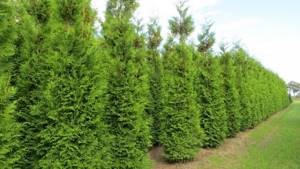
Thuja occidentalis 'Brabant'. © ebben
Thuja occidentalis "Smaragd"
Thuja occidentalis "Smaragd" is an evergreen coniferous tree with a regular cone shape. Gaining 10 cm in height every year, it can grow up to 5-6 m in height. Smaragd is distinguished by a beautiful symmetrical shape, which practically does not require pruning, and bright emerald needles. The surface of the needles is shiny, and when the sun’s rays hit the tree, it shimmers, filling the space around it with a feeling of celebration.
Thuja "Smaragd" grows best in places protected from the wind, in areas with fertile, moist soil. In dry summers, frequent watering, spraying and mandatory soil mulching are required. It loves a sunny location, but in this case it will require shelter for the winter: the sun and frost can dry out the needles. A good place for planting is shade during the midday hours.
"Smaragd" is the most frost-resistant thuja. It will withstand frost even at -40°C, but it needs to be protected from sunburn. That is why she needs shelter for the winter for the first 2-3 years.
Thuja "Smaragd" is one of the favorite plants of many designers. A small group of literally three plants will decorate and make an ordinary lawn stylish. Arborvitae planted in a row will decorate an alley or separate a zone. This beauty will always find a place in both coniferous and decorative deciduous compositions.
Read the rules for using conifers, including thujas, in landscape compositions in the material Flower garden with conifers - rules for organizing and choosing plants.
Thuja occidentalis "Golden Globe"
This is an original spherical shrub. Its name in Russian is just that – golden ball. A very beautiful miniature coniferous plant. The dimensions of an adult do not exceed 80 cm in both height and width. The shrub grows slowly and is finally formed only by 10 years. The effectiveness of the thuja is given by the needles - bright green with golden-yellow tips of the shoots. By autumn, the golden color changes to copper, and in the spring, with the beginning of growth, the bush is again covered with gold.
Like other types of thuja, Golden Globe prefers moist, nutritious soil, although it can also withstand short-term drought. With a regular lack of water, the needles will lose their brightness, become sparse and inconspicuous. For this variety, the location is very important - in full shade the needles will not have a golden hue, and in full sun the shoots can burn. Therefore, when landing the “golden ball”, it is necessary to find a middle ground. Openwork partial shade is an ideal place. Otherwise, this variety is similar to other western thujas - unpretentious, frost-resistant, and responds well to pruning. Requires shading from the spring sun.
Thuja "Golden Globe" is one of those plants that always has a place. The “Golden Ball” will decorate any design, be it the landscape of a site on Rublyovka or a cozy courtyard in Prostokvashino. Its value also lies in the fact that it is an ideal plant for creating contrast in a living composition in both shape and color.
Less common, but also growing and developing well in difficult climatic conditions, are other varieties of western thuja:
- Thuja occidentalis "Sunkist" is a cone-shaped shrub with golden needles. The height of an adult plant is 3 m, the diameter of the needles is 1.5 m;
- Thuja occidentalis "Rheingold" is a slow-growing spherical shrub with yellow-golden needles. Maximum dimensions 3 m in height and width;
- Thuja occidentalis "Teddy" is a globular dwarf among all dwarfs. At 10 years old, the height of the bush can reach as much as 30 cm! The needle-shaped needles are soft, dark green in color, and by autumn they acquire bronze tones;
- Thuja occidentalis "Holmstrup" is a slow-growing tree with a narrow pyramidal shape. Maximum height 3.5 m, annual growth 10-12 cm. The needles are dark green, dense;
- Thuja occidentalis “Pyramidalis compacta” is a thuja with a telling name. Compact tree with a pyramidal shape. The height of an adult plant is 5 m. The juicy green needles turn somewhat brown in winter;
- Thuja occidentalis "Mr. Bowling Ball" is another species of dwarf globular thuja. Thanks to the peculiar needles with long tips, it looks like a prickly ball. The height of an adult plant is no more than 70 cm, width 1 m. It grows slowly, increasing shoots by 5-10 cm per year.

Thuja occidentalis 'Smaragd'. © KM
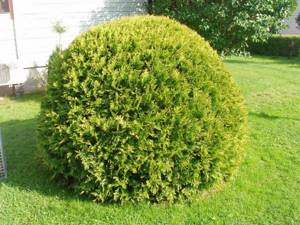
Thuja occidentalis 'Golden Globe'. © Vladimir Green
Thuja foldata "Can-kan"
Thuja "Kan-kan" is an original evergreen coniferous plant. Despite its miniature size, and an adult tree does not exceed 1.5 m in height, it grows quite quickly. In a year, “Kan-kan” increases by about 10 cm in height.
The long shoots of the tree branch well, but are directed chaotically. Because of this feature, the young thuja does not look very neat, but with age, the growing shoots, becoming denser, give it the shape of a cone.
The needles of the thuja "Kan-kan" are rich green and shiny. And one more important feature: it does not change color in winter. At the beginning of summer, the thuja looks especially attractive due to its young growth that is soft green in color with golden tips.
Thuja "Kan-kan" grows well in openwork shade on moist, fertile soils. It lends itself well to shearing, which is easy to tolerate and quickly grows new needles. It easily copes with urban pollution, but does not tolerate frost well. Temperatures below 28°C may not have the best effect on it - the shoots freeze in such frosts. Therefore, winter shelter is especially important for this variety, and both the tree itself and the soil around it need to be covered.
To do this, the tree trunk circle of the thuja is covered with a thick layer of sawdust, straw or pine litter for the winter. The tree itself is first wrapped with twine in a spiral, trying to press the branches to the trunk, and covered on top with agrofibre or burlap. This measure will protect the branches from falling apart during heavy snowfalls.
For information on how to properly prepare coniferous plants for wintering, including thujas, read the material 7 conditions for successful wintering of coniferous plants.
All the described western thujas, like the thuja foldata "Kan-kan", are unpretentious, undemanding to soil and weather conditions. With good care, they can withstand both severe frosts and hot, dry periods and are little affected by diseases and pests. All thujas respond well to shaping. Another thing is that not everyone needs a uniform. Each variety can be used in landscape design both as a single plant and in a group of other coniferous or deciduous plants.
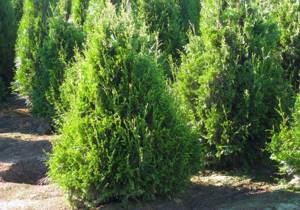
Thuja plicata 'Can-can'. © Erik

At the beginning of summer, thuja "Kan-kan" looks especially attractive due to its young golden growth. © GoldenPlants
Purchasing seedlings with an open root system
Seedlings with an open root system are much cheaper, but are not without drawbacks, the main ones being strict requirements for planting time and possible problems with the preservation of roots. It is best to plant such plants in the spring, starting from the moment the soil thaws, at the moment of activation of sap flow, when the regenerative and adaptive properties of thuja increase significantly.
After purchasing a seedling with an open root system, it must be immediately planted in open ground, or, if for some reason this is impossible, buried in a place sheltered from direct sunlight at a slight angle, making sure that the roots are well covered with soil or moist sawdust.
When choosing such a seedling, you need to pay attention to the following indicators:
- The root system of the plant must be well-formed, powerful, and have many thin (absorbing) roots.
- The total mass of roots should be comparable in size to the above-ground part of the seedling.
- The root system should not be overdried, otherwise the plant will not be able to survive the transplant. The shoots should have a white-pink tint and bend well. If the color of the roots has brown shades, and the shoots have become soft, they have rotted and will not be able to fully perform their functions.
- The soil around the roots should be moist and firm. When transporting it, it should be tied well to avoid damage.
- The trunk and crown of the thuja should not have significant damage.
- It is better to give preference to those seedlings that have not yet emerged from dormancy - the survival rate of such plants is much higher.
Teddy
Culture fits into the design of any site. It is used to decorate flower beds, alpine slides, and parks. The bluish-green needles are practically not prickly. It is better to plant the plant in a sunny area. If it grows in the shade, then the crown has an unattractive appearance.

In order for the thuja to develop well, mineral fertilizers are used. The distance between plantings should be 0.5 m. The crop loves moisture, so it is recommended to water it regularly and also loosen the soil. If planting was carried out during a dry period, then watering should be increased.
Columna
The variety grows quickly and has a columnar shape. The branches of the tree are densely spaced, so the crop is often used for hedges. In the warm season, the needles are bright green; in winter they turn brown. Trees are planted in a continuous strip or separately. They always look great on the site.
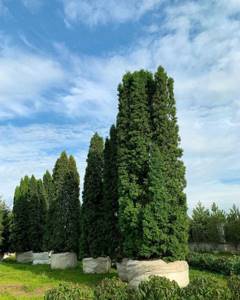
The tree may be affected by rot. If the thuja turns yellow, then you should take immediate action. The branches will gradually darken and begin to die. Fungal disease is treated with Fundazol. The crown is sprayed with this product until the plant recovers.
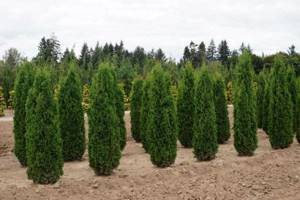
Benefits of dwarf thujas
Dwarf shrubs are quite ornamental plants; with their help, the garden will look neat and well-groomed. Arborvitae are a member of the Cypress family, a type of evergreen plant, which means that even in winter they will delight with their greenery. They are often used in landscape design and in planting hedges . Shrubs of this species are not picky in their care, which significantly reduces the time spent on creating beauty in the garden.

Thujas are also capable of purifying the air: walking next to the bushes in the garden will be beneficial for humans. A living fence made from these plants can reduce noise. Thanks to this, there will be no problems sleeping, and it will also have a positive effect on hearing
What height is better to choose
The price of thuja seedlings directly depends on its height and age. Young plants, the height of which does not exceed 25-30 cm, are much cheaper than grown seedlings, the height of which can reach 5 meters.
Purchasing young specimens is important for medium-winter-hardy varieties, since young plants are highly adaptable and easier to master after transplantation. Also, buying young thujas can be beneficial when choosing fast-growing forms, in cases where a large number of identical plants are required, for example, to create a hedge.
If the owner of the site is confident in the reliability of the plant, you can give preference to older specimens. This will allow you to quickly create the desired composition and the costs will be offset by the absence of the need to wait several years until the thujas reach the required size.
Globoza
Western thuja has a spherical shape. The shrub is popular among gardeners all over the world. The dwarf culture reaches a height of no more than a meter. It is resistant to frost and various diseases. There are green scales on the branches. In winter they turn brown.
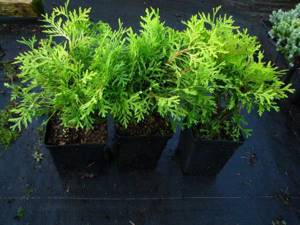
The bush grows slowly and is long-lived. There are specimens that are already more than 2 hundred years old. Globoza is easy to care for and does not require much attention.
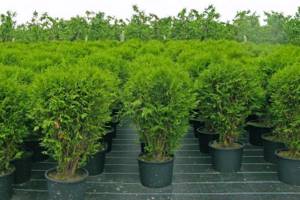
Shrubs are planted in spring or autumn. It is adversely affected by drafts, so you should be careful when choosing a landing site.
